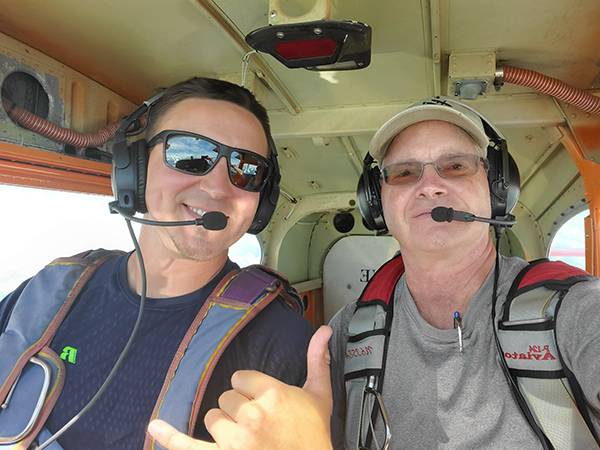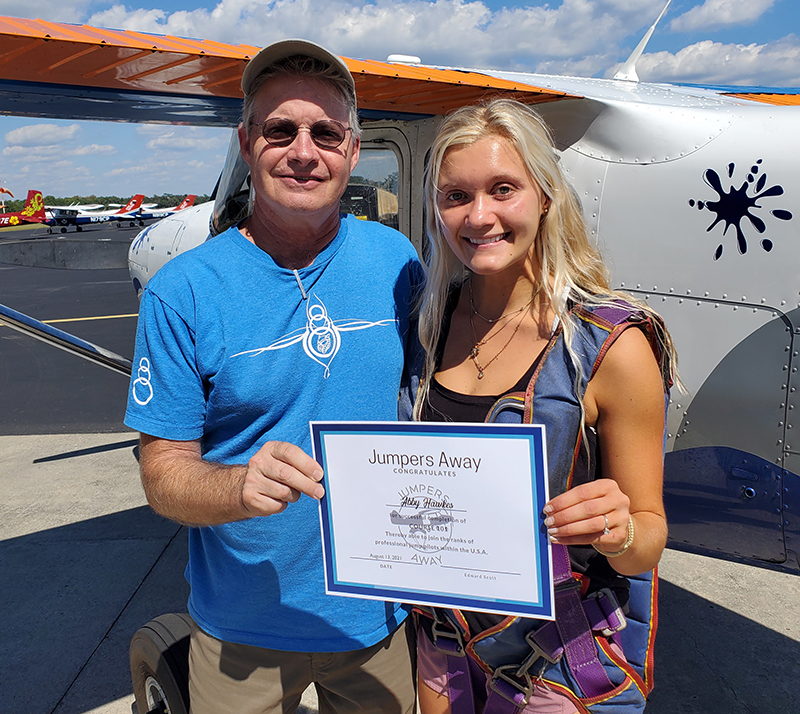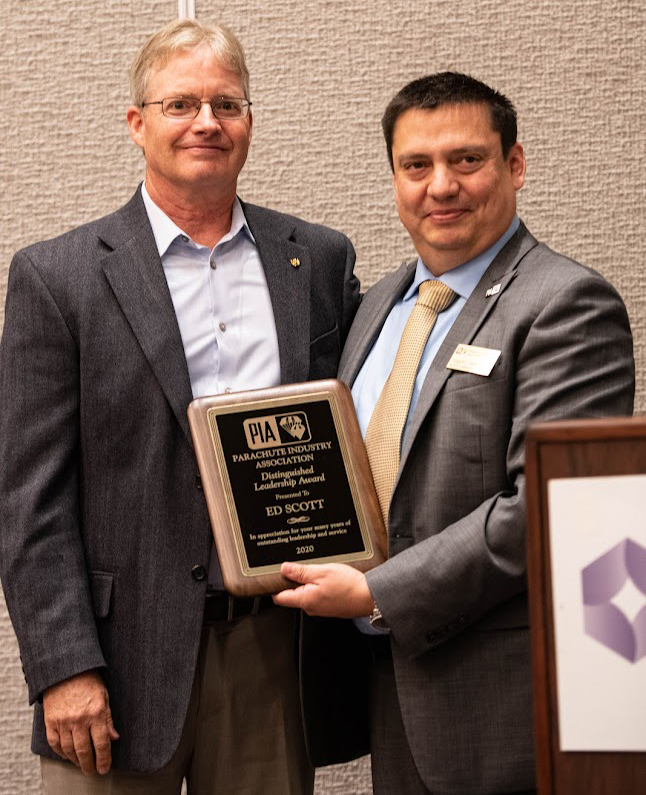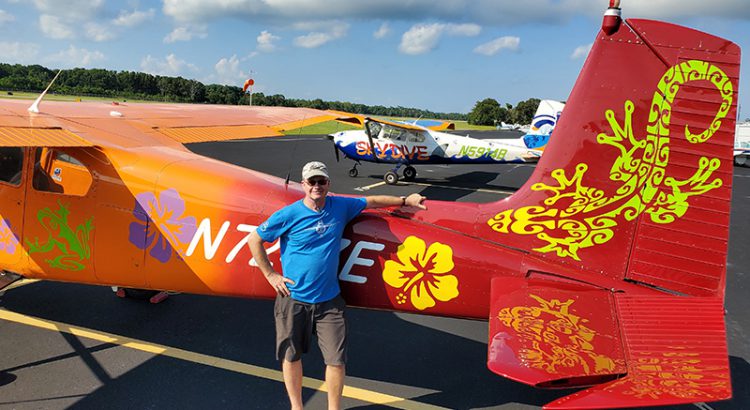Photo above – Ed Scott stands next to a jump plane on the ramp at Cape Fear Regional Jetport in Southport, NC.
In 1999, three years after Ed Scott began working for the United States Parachute Association (USPA) as the conduit between drop zone (DZ) owners and the FAA, the U.S. had one of the worst seasons for fatal jump plane accidents—five fatal crashes that killed 26 people. The focus for USPA and Scott, then turned to addressing jump plane safety through improved jump plane maintenance and jump pilot training.

“I’m pleased to say we turned things around to the point that the sport began to average just one fatal crash per year, earning a fatal crash rate that was better than general aviation’s overall rate,” said Scott. In fact, Scott shared that there have been no fatal jump plane accidents in the past two years—2020 and 2021. “Through that work it became my passion to help raise the level of jump pilot training, and so I started a jump pilot school.”
Jumpers Away, opened in May of 2021, operates at the Cape Fear Regional Jetport—KSUT—located near Oak Island, along the Southeastern coast of North Carolina. “What a great airport,” said Scott. “The facilities and service are top-notch.” There has been a drop zone—Skydive Coastal Carolinas—at the airport for 23 years and Scott says that all the local pilots, flight schools and air tours work hard to ensure the traffic pattern and operations are safe and seamless. “And, being on the coast, you can’t beat the view, especially from 12,000 feet,” said Scott.

Scott first began skydiving with a college club in his freshman year at Tennessee Tech University. He told the State Aviation Journal that he was just going to try it once, but he enjoyed it so much that he decided to pursue it as a sport, including earning his jumpmaster rating. “I enjoyed everything surrounding the sport,” said Scott, “the airplanes, the pilots, and the airport.”
Not long after, Scott transferred into the Aviation Management curriculum at Middle Tennessee State University. That degree helped him get a job with AOPA two years after graduating. While working for AOPA he earned his commercial certificate and began flying jumpers in a Cessna 182 at a nearby drop zone, which really added to his flight time. “I found it to be challenging and fun,” said Scott.
Drop zones are becoming busier than ever, Together, some 265 U.S. drop zones conduct over three million jumps a year, using nearly 400 jump aircraft, from Cessna 182s up to multi-turbine airplanes. Scott noted that jump pilots enjoy good pay and log lots of flight time, often quickly moving up to a DZ’s turbine jump plane. Being a jump pilot can be a fulfilling career, or a quick steppingstone to a flight department, charter or airline job.
“Like any pilot job, awareness and preparation are key,” said Scott, who focuses on the applicable regulations, the best procedures and the many abnormal and emergency scenarios that can happen. “I ensure each pilot understands the huge responsibility for the lives and future of everyone on board.” His mantra is that skydiving has risks but flying to jump altitude shouldn’t add to that risk. “A good jump pilot has good stick-and-rudder skills, flies smoothly and precisely, and is ready to handle anything.”
Scott admitted that there have been challenges starting a business during a pandemic. “A number of people warned me that a pandemic was the worst time to start a business, and they were right,” said Scott. “There have been huge challenges.” But Scott says that unique times call for unique approaches.
He feels like he can really help two groups. “I can help low-time commercial pilots get a paying job that will let them quickly build logged hours. And I can help drop zone owners by supplying trained and prepared jump pilots,” said Scott. It is a high-turnover industry and DZs need new jump pilots every year. Typically, the DZ owner has to train low-time commercial pilots themselves, which takes time and takes the airplane away from skydiving use. Scott says he can provide a DZ with a trained jump pilot, ready to fly skydivers on Day 1.
The Jumpers Away program is approved by the largest jump plane insurer, and they’ve readily added his graduates, many with under 300 hours, to DZ insurance policies. Jump pilots earn from $15 to $20 per load and a Cessna 182 jump pilot can easily fly 15 or more loads per day at a busy DZ. It isn’t uncommon for a jump pilot to log up to 400 or 500 hours in a year.
Jumpers Away trained five pilots in 2021 who all quickly found jump pilot jobs. “Now that the word is getting out, more commercial pilots are making queries. So, I’m expecting more jump pilot candidates for 2022.

Last year Scott was presented the Parachute Industry Association’s 2020 Distinguished Leadership Award at a joint PIA/USPA board dinner. “I was pleased to receive it on behalf of the USPA staff, who were instrumental in our success,” said Scott.
PIA’s news release said: “Ed’s leadership over the years advanced the sport, government interaction and industry relationships. While increasing the numbers of skydivers and drop zones he led the team that promoted safety awareness that saw a decrease in fatalities and kept government intrusion in check. In addition, Ed recognized the importance of the USPA relationship with PIA and fostered that relationship.” PIA President Roberto Montanez presented the award to Scott.
“I was quite surprised and deeply honored when informed of PIA’s decision,” said Scott. “It was quite meaningful, knowing that PIA represents all facets of skydiving–drop zone owners, parachute and component manufacturers, and riggers among them. In my years at USPA, we worked very closely with PIA on issues affecting the sport of skydiving and I was grateful to receive their recognition.”



